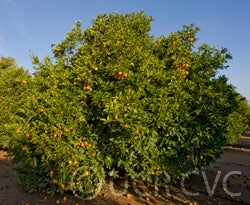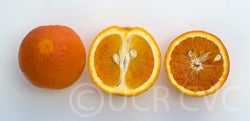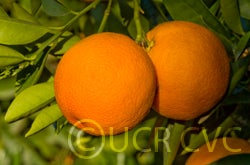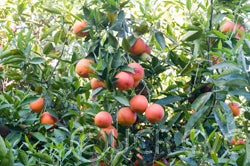Citrus sinensis (L.) Osbeck
CRC 3827
PI 539551
VI 272
Source
Received as budwood by USDCS, Indio, CA, via CCPP, 1965.
Parentage/origins
Ruby blood orange was introduced from an unknown Mediterranean country to Florida about 1880 and brought to California soon after.
Rootstocks of accession
Carrizo citrange, C-35 citrange
Season of ripeness at Riverside
December to February
Notes and observations
OJB: The development of blood coloration in Ruby is variable and for this reason, it has not become a popular variety. In California's coastal region, it never develops red pigmentation. Ruby is at its best in hot interior districts, however under these conditions the pigmentation is still variable. Ruby has since been used as a parent variety in the development of new varieties of citrus and it has been found that although Ruby itself is poorly colored, its progeny tends to be very highly colored.
Description from The Citrus Industry Vol. 1 (1967)
"Fruit medium-sized, globose to slightly oblong; faint areolar circular furrow or ridge; seeds relatively few. Well-colored, with reddish flush under favorable conditions. Rind medium-thick, finely pitted, and lightly pebbled. Flesh tender and juicy; flavor rich. Flesh color orange, streaked (rather than flecked) with red under favorable conditions. Midseason in maturity.
Tree moderately vigorous, compact, medium-large, and productive.
The Ruby variety was introduced from the Mediterranean (country unknown) to Florida about 1880 and brought to California not long thereafter. From its appearance and behavior, it may prove to be an old Italian variety. In both Florida and California, Ruby is highly uncertain and variable with respect to development of blood coloration. For this reason, it has not become popular and remains merely a novelty. In California's coastal region, it never develops red pigmentation. Ruby is at its best, with marked variability, however, in hot interior districts. In such districts, the quality is excellent and part of the crop colors beautifully.
Several unnamed clones or selections are known to exist which differ in blood coloration development and other minor respects."
Availability
Commercially available in California through the Citrus Clonal Protection Program. Click here to order budwood.
USDA Germplasm Resources Information Network page for Ruby blood orange



